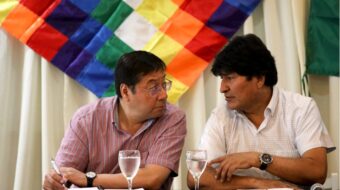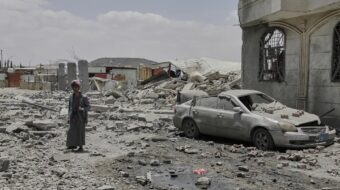
On return from our SOA Watch delegation to Colombia and Panama, I traveled by bus to Caracas with my son, Pachi. I took advantage of the long ride to sift through my notes from the trip.
Maybe it was the bumpy road or perhaps my wandering heart, but the statistics I kept reviewing on Colombia seemed jumbled. Was 3.4 million the number of internally displaced people there, as one set of my notes said, or 4 million as another said? Did it really matter which one? The sheer enormity was overwhelming.
In the Colombian jungle
I closed my eyes with the blur of numbers, and as the bus sped forward I recalled the motion on a canoe a week earlier, cutting through a river in the Colombian jungle. Slowly, the images of two of those 3 or 4 million faces came into sharp focus. One was of a young woman who shared the rickety bench on the canoe with me. Her daughter sat between us. Her name was Juliet, such a regal name for a little girl living on the edge of a river in a jungle immersed in war. She was 3 years old and had pink sandals. Much to Juliet’s delight, her mother spent much of the canoe trip pointing out the cows along the riverbank, acknowledged by Juliet’s squeals of joy. They were much more interesting to Juliet than the parrots, eagles, egrets and crocodiles that delighted us. Given the nature of our trip — a delegation to a local military outpost to denounce recent paramilitary attacks and military harassment — and the risks of speaking out in Colombia, I was touched by the spirits and bravery of Juliet’s mother.
Latin America initiative
The visit to the small jungle military outpost wasn’t really in our plans. Our small group of four was in Colombia as part of the Latin America initiative of the SOA Watch to visit the countries that send students to the School of Americas. We had already visited seven countries of South America where we met with several government leaders who agreed both to the immediate removal of their troops from the SOA (Venezuela, Argentina and Uruguay) and to a gradual withdrawal (Bolivia). In the other countries we met with civic organizations and members of Congress who joined forces in calling for withdrawal of their country’s troops from the SOA. We knew that as we moved north it was unlikely we would encounter the same openness.
And of all countries yet to visit, Colombia would be the most challenging. Not only does Colombia hold the record for most SOA graduates — over 10,000 — it also has the largest current enrollment.
More importantly, the abuses by SOA graduates in Colombia are taking place in the present tense.
Indeed, our formal requests to meet with government officials went unheeded. Our main purpose in Colombia, however, was to hear first-hand the stories of those living in conflict zones, and to understand what role the United States was playing, especially that of its School of the Americas.
Questions on Plan Colombia
That is why we found ourselves on that canoe, deep in the lush river area of northern Colombia called the Magdalena Medio, in the company of our guides from the Christian Peacemaking Team. The previous evening they had brought us by canoe to the village of Puerto Matilde, a community of 25 displaced families whose new wooden houses huddled together at the river’s edge.
Unlike the majority who had fled the rural violence for the city, those in Puerto Matilde were determined to remain on the land. Many nearby villages had been drastically reduced in population due to the armed conflict. Their land has been usurped by large landowners and converted to the production of African palms. Some 8 million hectares of land have been abandoned by the fleeing displaced, much of it now in the hands of multinational corporations.
Several human rights organizations suggest that the real motivation behind the billions of dollars the U.S. spent for Plan Colombia might be to turn over to multinationals the country’s rich natural resources, e.g., oil, gold, water, jungle, etc.
Indeed, the purported reason for Plan Colombia, the “war on drugs,” just didn’t make sense when looking at the results. After billions of spent dollars, millions of displaced citizens, thousands of lost lives, and dozens of ecosystems destroyed by fumigation, drugs are more available than ever on the streets of the U.S. and coca is now grown in 23 departments (provinces or states) of Colombia, almost double the 13 departments where it was planted at the onset of Plan Colombia.
Visiting Puerto Matilde
That night we had gathered around the only light bulb in the village, and were each served a different plate of food, collected from a different household. It was a communal way of hosting us, and in the same way, mattresses and mosquito nets were later collected and neatly laid out for us. Over dinner we batted mosquitoes and considered the request the community had made to us. They wanted us to accompany them the following morning to visit a military battalion that had installed itself in a nearby town.
Colombian President Uribe boasted that tens of thousands of paramilitaries were laying down their arms and returning to civilian life (which includes free housing, several years of a fixed salary and almost complete impunity for their crimes). Yet the lives of the people of Puerto Matilde spoke to the contrary.
Weekly, neighbors were being killed for crimes such as buying food. In the port city of Barrancabermeja, the paramilitary openly demanded regular “vaccinations” or war taxes for every kilo of rice and beans that was taken by boat. Too many kilos meant death, upfront and outright.
How could we say no to their request? The next morning we boarded the canoe with Juliet and others.
Canoeing to Sgt. Ruiz
After the morning’s journey past cows and crocodiles, we docked at the little town of San Francisco, met by soldiers armed for what looked like an assault on Guadalcanal. After having us frisked upon arrival, the commanding officer, Sgt. Ruiz, smiled and said that he would be glad to meet with us, and that he personally thought that all guns should be converted to guitars. It was a bit hard to believe given the amount of hardware draped from his shoulders, but we managed to smile.
As we sat down in the reprieve of shade, Ruiz ceremonially took off his machine gun and laid it on the table, but his young soldiers stood armed and alert.
One of our hosts, Don Rayo, spoke first of his neighbor who had gone to buy food and had never returned. His horse was found hung from a tree.
Juliet’s mom told of the paramilitary showing up to threaten members of the town, who then had to escape. One was a nurse and her skills were missed. The sergeant indicated that he could not guarantee her safe return because of her crime: she had tended a wounded guerrilla.
And so have we all, Juliet’s mom said. Who can turn down a request when a gun is being pointed at one’s child?
I looked around the circle and wondered. What would happen to these people of Puerto Matilde who were being so forthright?
Almost reading my mind, they added, “We are able to say these things today because of these visitors from the U.S. They are our guarantees that nothing will happen to us. Do you agree, sergeant? Can we be sure that we will be safe?”
“Why of course,” said the sergeant, who clearly wanted to be on our good side and kept talking about converting guns to guitars.
U.S. people can help
Three things became clear to us in this and all or our visits in Colombia:
1. The main victims in this conflict are the civilians
2. Plan Colombia, funded by U.S. taxpayers — you and me — has accelerated the violence and displacement.
3. As U.S. citizens we have a large measure of responsibility in the Colombian violence and also a huge potential to contribute to peace there.
Perhaps we can’t all travel to Colombia, to the rivers and sit beside citizens in meetings like this (for those of us who can, please come). But at least we can all make a phone call to our congressman. Or even visit him or her. After all, our dollars keep the conflict going.
Top commanders in the war zones are SOA grads. The SOA is not only in Georgia, but in Colombia as well. Thousands of U.S. military personnel who have passed through Colombia are teaching those same “skills,” far outside the spotlight the movement has shined on SOA.
Different in Panama
Shortly after leaving Puerto Matilde, we traveled to Panama. We found a very different country, yet linked to Colombia by a common border and two sides of the SOA story.
While the strongest presence of the SOA is currently in Colombia, it had its beginnings in Panama. From 1946-1984, the school was located there. We had a long visit with the former president of Panama, Jorge Illueca, who shared with delight his story of booting the school out of the country. He had previously served as President of the UN General Assembly, but is told that he will be more remembered for his role in closing the SOA.
Now in his nineties, Don Jorge shared hugs and congratulations for our efforts to close down this “School of Assassins,” a term he coined when ousting the school.
Shocking news exposed
After its removal from Panamanian soil, the SOA received no students from that country for 18 years. However, slowly and quietly, Panama’s two recent governments began sending police there (Panama has no army). We discovered after meeting with the Attorney General and even the president’s brother and advisor that even they weren’t aware of this, much less the public.
We quickly altered this, providing the public with information via plenty of access we obtained to major media outlets. There, we poked the beehive, sharing what Panamanians discovered to be shocking news that their police were once again attending an institution that was despised in their land. Even after we left, debate continues in the press, and organizations have joined to look at ways to pressure the government to reverse this situation.
Transforming horror into beauty
We knew we couldn’t leave the country without visiting the former site of the SOA, now converted into a hotel. Our tour guide — the former bishop of Colon — showed us how the lobby has been transformed into a peace monument. A huge marble star adorns the floor, surrounded by a marble compass, a call for peace to be spread to all parts of our earth. The beauty of the grounds took our breath away, and we wondered how a house of horrors could have possibly existed amidst such loveliness.
The transformation of a place of violence into a haven of beauty was repeated on our last night in Panama.
The Maryknoll Sisters invited us to visit their project, a retirement home for low-income Panamanians. We found that the sisters’ project was located in the former U.S. military base where tens of thousands of troops were stationed before the canal was returned to Panama.
Upon the troops’ departure, Sister Gerri suggested to authorities that a wonderful use of the land would be that of a new site for the retirement home for needy elderly Panamanians. They agreed, for the sum of one dollar.
As the sun went down and brought a welcome cool to the surrounding tropics, we visited the former bunker transformed into the center for total care. Four-foot walls had been whitewashed and were covered with butterflies painted in all colors.
Inside, gun vaults were converted to closets holding pink and turquoise dresses and straw hats. The lookout room was filled with several dozen brightly dressed elderly who took our hands firmly and kissed our cheeks, and welcomed us to their home.
It was the death of two Maryknoll sisters at the hands of SOA grads 27 years ago that shed light on this School of Assassins, and led to the huge movement which now demands an end to this school. It seems fitting that their fellow sisters were showing us one of the many ways we can transform a place of war and violence into one of beauty and welcome.
Lisa Sullivan of the SOA Watch Latin America office traveled to Colombia and Panama in January with Fr. Roy Bourgeois of SOA Watch, Pablo Ruiz of Chile’s Observadores de la Escuela de las Americas and Linda Panetta of SOA Watch Northeast.
What is the School of the Americas?
The School of the Americas (SOA), in 2001 renamed the “Western Hemisphere Institute for Security Cooperation,” is a combat training school for Latin American soldiers, located at Fort Benning, Ga.
During its 59 years, the SOA has trained over 60,000 Latin American soldiers in counterinsurgency techniques, sniper training, commando and psychological warfare, military intelligence and interrogation tactics. These graduates have consistently used their skills to wage war against their own people. Among those targeted by SOA graduates are educators, union organizers, religious workers, student leaders, and others who work for the rights of the poor. Hundreds of thousands of Latin Americans have been tortured, raped, assassinated, “disappeared,” massacred, or forced into refuge by those trained at the School of Assassins.
— From School of the Americas Watch









